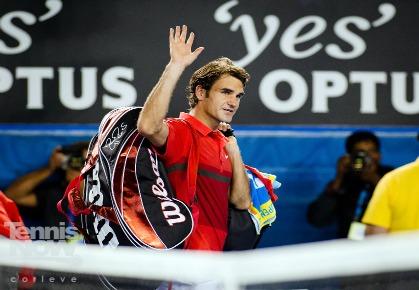By Chris Oddo Photo Credit: Mark Peterson/Corleve

“If I go up to the net, I hit to his backhand,” writes Rafael Nadal of his strategy for playing Roger Federer in the 2008 Wimbledon final, in his book, Rafa. “Not to his drive, his strongest shot. Losing your concentration means going to the net and hitting the ball to his forehand, or omitting in a rush of blood to serve to his backhand – always to his backhand – or going for a winner when it’s not time.”
It may seem strange that Rafa’s strategy against Federer could be so simple, but it is. As much as we’ve all seen Federer’s majestic backhand wreak havoc on other opponents, the cold, hard truth is that it is grossly mismatched against Nadal’s lefty serve and forehand, and Nadal takes the court knowing that he can grind Federer down this way. It’s not that Federer has a weak backhand, either. He’s got one of the best one-handed backhands in the history of the sport.
The problem is, the one-hander is becoming a dinosaur in the modern game. And Nadal is the prototypical modern player, primed to feed on this dinosaur. With high-bouncing topspin and relentless pace and depth on his shots, Nadal creates chaos for Federer’s backhand. In moments of inspiration Federer can hit clean, aggressive shots from that side, but almost always, over the course of a long match, it is the primary reason that Nadal is able to dominate him with such regularity.
It’s probably also the reason that other wildly gifted one-handed players such as Stan Wawrinka (ranked No. 22, 0-7 lifetime vs. Nadal), Nicolas Almagro (ranked No. 10, 0-7 lifetime vs. Nadal) and Richard Gasquet (ranked No. 18, 0-10 lifetime vs. Nadal) have all been blown off the court by Rafa each time they have faced him. Yes, there have been exceptions to the rule (Mikhail Youzhny has four wins vs. Rafa, but three were before ’06), but by and large it holds fast. A one-handed backhand is a death sentence against Nadal, and Federer has done remarkably well just to win 9 of the pair’s 27 career matches.
I asked Federer last year if he thought that players who hit the one-hander would be able to make it to the top of tennis anymore. It seems like the double-handed backhand has maybe a slight advantage,” he said. “I think slower conditions might favor a double-handed backhand, but then I’m not sure if that’s the right thing I’m saying. Honestly, time will tell. I guess we’ll see.”
Time is telling observers that the one-hander may be fine against everybody else in tennis, but for a right-hander, even one with a versatile, technically perfect backhand like Federer, Nadal is a complete nightmare to face. We saw it yesterday and we’ve seen it throughout the history of the rivalry.
Strangely, Nadal claimed after the match that he didn’t rely on the matchup as much in their semifinal match yesterday. “I didn't play all the time against his backhand like I did a lot of times,” said Nadal. “Today I think I played more normal match, playing in his backhand, playing in his forehand, too.” It didn’t seem that way to me. Nearly every serve hit by Nadal went to Federer’s backhand or body, and he still relied heavily on the pattern from the baseline throughout the match as well.
It’s a very interesting tactical struggle that Federer and Nadal finds themselves engaged in when they play. Even though the rivalry has been bogged down by Federer’s lack of success at the Slams against Rafa, it’s been enhanced by the complex tactical approach that each takes against the other. It seems like Federer has gotten a lot closer to finding a workable gameplan against Nadal, but he’s still unable to hit enough good backhands (or avoid having to hit them) to win.
What’s amazing to me is that Federer was still able to do enough to have many opportunities to win their semifinal. There was a third set tiebreaker, and Federer also missed an inside-out forehand by inches that would have given him a chance to serve for the fourth set.
In the end, we all know how it went. Rafa stuck to the script, hammered away at Federer’s backhand, and was clearly the better player for it. Federer, meanwhile, might have spent too much time trying to get Rafa off of his script, and not enough time writing his own. It’s complicated when you’re the guy with the one-hander, especially when it’s Rafa you have to deal with.